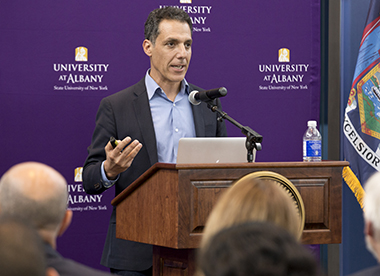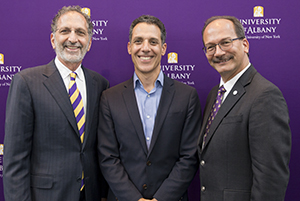Malicious Online Content? Computer Science Can Beat It
 |
|
Hany Farid ’92 delivers the third annual Massry Lecture. (Photos by Carlo de Jesus) |
Albany, N.Y. (September 15, 2017) — There is something about natural disasters that bring out the worst in Photoshoppers. Hurricane Harvey hits Houston and someone tweets out a photo of a shark swimming down the freeway.
But a doctored photo going viral is not always fun and games.
This is where the work of UAlbany alum Hany Farid can help, because he has innovated technology that can verify authenticity, or lack of it, in digital imagery. Using a mathematical algorithm, systems can catch — and prevent from spreading — images involved in cybercrime and other illegal activities.
Farid ’92 delivered the third annual Massry Lecture on Sept. 14, “Reigning in Online Abuses.” He addressed the many ways online platforms are being used to disseminate malicious content. These threats include online extremism, malware, fake news, child pornography and more. Often the content includes photos that are fabricated, altered or taken from different situations and times.
To combat these threats, Farid developed a software called PhotoDNA that can identify and prevent an image from continuing to circulate by extracting from the image its “digital signature.” PhotoDNA also helps companies remove terrorist content, according to Farid, a senior advisor to the Counter Extremism Project (CEP).
“We are getting much more serious about cracking down on the ability to weaponize the Internet,” said Farid, who has been dubbed "the father of digital forensics."
The software, created in conjunction with Microsoft Research and NCMEC, launched in 2009. It has since been used by major tech companies such as Facebook, Twitter and Google. Farid said Facebook has reduced its child pornography content by 90 percent since adopting the software in 2010.
 |
|
Left to right, I. Norman Massry, whose family makes possible the Massry Lecture Series, computer scientist Hany Farid '92 and President Rodriguez get together after Farid's keynote address. |
Farid is also working with the United Nations and the CEP to “develop the next generation of technology,” building on the photo technology to apply similar tools to video and audio content, he said.
Farid received his Master’s in Computer Science from the University in 1992 and is the Albert Bradley 1915 Third Century Professor of Computer Science and chair of computer science at Dartmouth College.
Welcome Remarks from the President
Havidán Rodríguez, in his first week as UAlbany’s 20th president, opened the lecture with welcoming remarks. “I want to thank the Massry family for making this possible,” he said. “Without your support and commitment, we would not be here today.”
The Massry Family’s 2014 gift of $5.25 million supports the School of Business and key University-wide initiatives.
“Through their vision, their engagement, commitment and generosity to our university, we’ve done great things, and we will continue to do great things,” Rodríguez said.
![]() For more news, subscribe to UAlbany's RSS headline feeds
For more news, subscribe to UAlbany's RSS headline feeds
A comprehensive public research university, the University at Albany-SUNY offers more than 120 undergraduate majors and minors and 125 master's, doctoral and graduate certificate programs. UAlbany is a leader among all New York State colleges and universities in such diverse fields as atmospheric and environmental sciences, business, education, public health,health sciences, criminal justice, emergency preparedness, engineering and applied sciences, informatics, public administration, social welfare and sociology, taught by an extensive roster of faculty experts. It also offers expanded academic and research opportunities for students through an affiliation with Albany Law School. With a curriculum enhanced by 600 study-abroad opportunities, UAlbany launches great careers.


